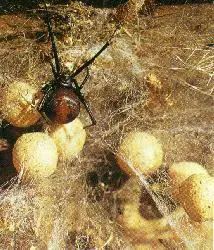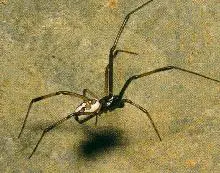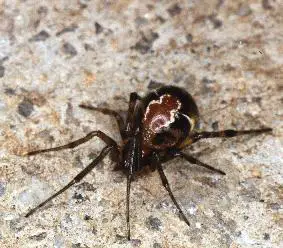Hundreds of people are bitten by Red-back Spiders every year, however very few are seriously injured. (Check out a news article at the end of this page.) Its close relative, the Black Widow Spider, is probably the most common cause of serious spider bites overseas. An almost identical spider, the Katipo, is the only venomous spider in New Zealand. In 1987, the Brown Widow Spider (Achaearanea) (below right) was found in Brisbane. This is not considered highly dangerous to humans but nonetheless it could make young children quite ill. Its venom would be neutralized by Red-back antivenom.
The Red-back is found in all parts of Australia except in the hottest deserts and on the coldest mountains, so be especially cautious if you find yourself having to reach in places where you have limited visibility.
It is the only dangerous spider with an Australia-wide distribution. Our other dangerous spider, the Funnel-web spider has a more limited range, mostly along the eastern coastal areas. Red-backs are very common in Summer. The female Red-back has a spherical satin-black abdomen with an orange-red stripe. The abdomen is usually about 1 cm in diameter. Eight long delicate legs arise from the tiny front segment of the body.
The male is only about one-third the size of the female and is considered harmless to humans because his fangs are so small. The male’s markings are not as bright as the female as seen in this picture. It is usually easy to identify a female Red-back although her stripe may be orange, pink or even light grey.

After mating, the female eats the male. The female spins up to 8 round balls of web for her eggs. Some of these may contain as many as 300 eggs. If the weather is warm, the spiderlings hatch after about 2 weeks and will moult several times as they grow before they reach full size.
Unlike the Sydney Funnel-web, the Red-back is not aggressive and if molested will usually fall to the ground, curl up and feign death. If disturbed while guarding her eggs or cornered, she will bite the intruder with her small but effective fangs. Most bites occur when the spider is trapped against the skin e.g. when clothes are put on that contain a spider, or picked up in rubbish. Most bites occur on the hands or feet than the rest of the body.

Although this spider injects only a tiny amount of venom, it can cause serious illness and deaths used to occur before an antivenom became available in 1956. The action of the venom is unique as it can attack all the nerves of the body and in serious cases cause a paralysis which may lead to death. At first the bite is only as painful as a minor insect sting, but after a few minutes it becomes intense and spreads to other parts of the body. A special feature seen only with Red-back bites is that the bitten limb may sweat profusely while the rest of the skin remains dry. Fortunately the serious affects of the venom take several hours or even days to develop and there is plenty of time for treatment with antivenom. Remember that most bites can be avoided if you keep your eyes open for that tell-tale red stripe.

The Brown Widow is of the same group as the Red-back and the Black Widow but its toxin is about one-tenth the strength of the Red-back toxin and does not cause the same severe reaction. It can be a garden pest of plague proportions.
Click here for more photos of Red-back Spiders.
Information and pictures were taken from children’s projects and where credited to that child does not claim to be original information. Where possible, permission to reproduce has been sought. Any infringement of copyright is purely unintentional.
